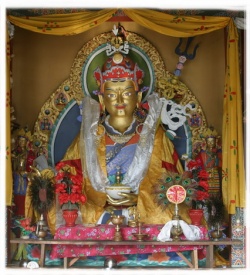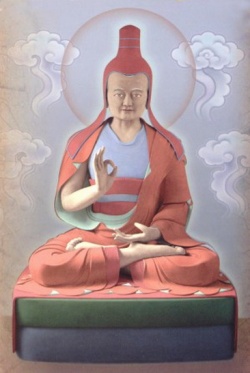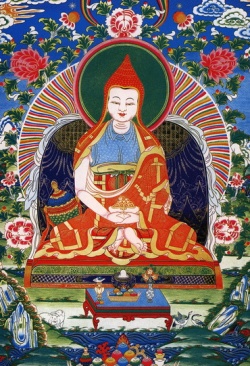Difference between revisions of "Ancient Lineage"
m (Text replacement - "He" to "He") |
|||
| Line 77: | Line 77: | ||
[[Longchen Rabjam]] is revered as one of the greatest [[masters]] in the [[Nyingma tradition]]. | [[Longchen Rabjam]] is revered as one of the greatest [[masters]] in the [[Nyingma tradition]]. | ||
| − | + | He wrote more than 250 treatises on a wide variety of topics, but is best known for his works on [[Dzogchen]], especially the extensive {{Wiki|scholastic}} {{Wiki|exegesis}} of the [[Dzogchen tantras]] known as the [[Seven Treasures]], the [[Chöying Dzöd]]. | |
| − | Although one of the most [[realized]] [[sages]] of [[Tibet]], with crowds of [[disciples]] following him wherever he went, he remained a simple [[hermit]] with minimal belongings, often dwelling in [[caves]]. | + | Although one of the most [[realized]] [[sages]] of [[Tibet]], with crowds of [[disciples]] following him wherever he went, he remained a simple [[hermit]] with minimal belongings, often dwelling in [[caves]]. He saw [[solitude]] in [[nature]] as a source of [[spiritual awakening]]. |
| − | For him, nature's [[peaceful]] and clear {{Wiki|environment}} inspired [[peace]] and clarity, enabling practitioners to unite with [[Wikipedia:Absolute (philosophy)|ultimate]] [[joy]], to attain the [[oneness]] of [[universal]] [[openness]] and [[luminous clarity]]. | + | For him, nature's [[peaceful]] and clear {{Wiki|environment}} inspired [[peace]] and clarity, enabling practitioners to unite with [[Wikipedia:Absolute (philosophy)|ultimate]] [[joy]], to attain the [[oneness]] of [[universal]] [[openness]] and [[luminous clarity]]. He avoided building [[monasteries]] and lived in [[solitude]], advising his followers to do the same. |
In the 18th century [[Jigme Lingpa]] (1730-1798), also known as [[Khyentse Özer]], [[Rays of Wisdom and Compassion]], discovered, as [[mind ter]], the vast and profound [[Longchen Nyingtik]] cycle of teachings together with some original [[Nyingtik tantras]], at the age of 28 years. | In the 18th century [[Jigme Lingpa]] (1730-1798), also known as [[Khyentse Özer]], [[Rays of Wisdom and Compassion]], discovered, as [[mind ter]], the vast and profound [[Longchen Nyingtik]] cycle of teachings together with some original [[Nyingtik tantras]], at the age of 28 years. | ||
| Line 127: | Line 127: | ||
[[Guru Rinpoche]] gave [[esoteric teachings]] and [[transmission]] of [[Vajrayana]] to hundreds of [[disciples]], his main students [[being]] the Twenty Five [[Disciples]] who are the [[root]] [[incarnations]] of the [[masters]] of this day. | [[Guru Rinpoche]] gave [[esoteric teachings]] and [[transmission]] of [[Vajrayana]] to hundreds of [[disciples]], his main students [[being]] the Twenty Five [[Disciples]] who are the [[root]] [[incarnations]] of the [[masters]] of this day. | ||
| − | + | He concealed thousands of [[Termas]] in many places for the [[benefit]] of {{Wiki|future}} followers, [[including]] in the [[essential nature of mind]] of his [[realized]] [[disciples]] where they were appropriate for the times. | |
Many [[realized]] [[masters]] and [[incarnations]] of [[Guru Rinpoche]] and his [[Twenty Five Disciples]] are [[Tertöns]], [[able]] to reveal these [[treasure teachings]] in the [[form]] of [[Mind Termas]], [[direct realization]], or [[Earth Treasures]], [[dakini scripts]] recovered from secret places, and only [[able]] to be deciphered by the [[Tertön]]. | Many [[realized]] [[masters]] and [[incarnations]] of [[Guru Rinpoche]] and his [[Twenty Five Disciples]] are [[Tertöns]], [[able]] to reveal these [[treasure teachings]] in the [[form]] of [[Mind Termas]], [[direct realization]], or [[Earth Treasures]], [[dakini scripts]] recovered from secret places, and only [[able]] to be deciphered by the [[Tertön]]. | ||
Latest revision as of 05:09, 11 January 2016
Click here to see other articles relating to word Ancient Lineage
Known as the Ancient Lineage, the Nyingma tradition dates back to the founding of Buddhism in the 7th century during the reign of King Songtsen Gampo (617-698).
It was fully established during the reign of King Trisong Detsen (790-858) through the efforts of the Indian scholar, Shantarakshita, the tantric master, Padmasambhava (Guru Rinpoche), and the scholar-translator Vimalamitra.
Its teachings belong to the Old Translation School, whereas the teachings of the Kagyu (founded by Marpa Lotsawa 1012-1099), Sakya (founded by Kohn Konchok Gyalpo 1034-1102) and Gelug (founded by Je Tsongkhapa 1357 - 1419) belong to the New Translation School.
During the late 9th century Buddhism had been suppressed by a hostile king, Lang Darma, and the New Translation school dates from its resurgence following his death.
The Nyingma tradition survived during this time through the strength of its yogic tradition that was not dependent on monasteries requiring royal patronage.
The tantras unique to the Nyingma are the three inner tantras:
Mahayoga,
Anuyoga and
Atiyoga (Dzogchen).
There are three lineages in the old translation school of the Nyingma tantras: the 'Distant Oral Lineage', from the direct oral teachings of the Buddha;
the 'Near Treasure Lineage' (terma) from teachings of discovered treasure texts, written and concealed in holy places by Guru Rinpoche, Khandro Yeshe Tsogyal and others,
for the benefit of future generations, and the 'Lineage of Profound Pure Visions', from teachings received by various Saints during visions in meditation and post meditation.
Atiyoga (Dzogchen), the highest teaching, has three divisions:
Semde,
Longde and
Mengakde.
Semde and Longde are associated with Vairochana and Vimalamitra,
while Mengakde is associated with Guru Rinpoche and Vimalamitra.
The latter, the direct oral pith instruction of the master to the disciple, is divided into four cycles:
Outer,
Inner,
Esoteric and
Innermost Esoteric Cycles.
The Mengakde teachings in general, and especially the Innermost Esoteric cycle became known as the Nyingtik, the Innermost Essence (Tulku Thondup).
The general Nyingma inner tantras were transmitted through three lineages:
mind direct, by symbol, and
oral transmission, the
latter being that of teacher to disciple.
In addition to the 17 root tantras, the Nyingtik includes many other tantras and teachings discovered by tertöns, revealers of treasure teachings.
Of all the treasure teachings, the Vima Nyingtik, transmitted in Tibet by Vimalamitra and the Khandro Nyingtik, transmitted by Guru Rinpoche, which were later propagated through the revelations and writings of Longchen Rabjam (1308-1363) are the most profound and elaborated teachings on Nyingtik.
Longchen Rabjam is revered as one of the greatest masters in the Nyingma tradition.
He wrote more than 250 treatises on a wide variety of topics, but is best known for his works on Dzogchen, especially the extensive scholastic exegesis of the Dzogchen tantras known as the Seven Treasures, the Chöying Dzöd.
Although one of the most realized sages of Tibet, with crowds of disciples following him wherever he went, he remained a simple hermit with minimal belongings, often dwelling in caves. He saw solitude in nature as a source of spiritual awakening.
For him, nature's peaceful and clear environment inspired peace and clarity, enabling practitioners to unite with ultimate joy, to attain the oneness of universal openness and luminous clarity. He avoided building monasteries and lived in solitude, advising his followers to do the same.
In the 18th century Jigme Lingpa (1730-1798), also known as Khyentse Özer, Rays of Wisdom and Compassion, discovered, as mind ter, the vast and profound Longchen Nyingtik cycle of teachings together with some original Nyingtik tantras, at the age of 28 years.
The Longchen Nyingtik is the heart essence of Longchenpa, revealed to Jigme Lingpa during a three year retreat at Chimphu.
At the age of 34 years, Jigme Lingpa moved from Chimpu to Tsering Jong in Southern Tibet where he built a simple hermitage with a meditation school.
It later became a nunnery until around 1959 when everything disappeared in the political turmoil.
Since the 1980s once again Tsering Jon has been re-established as a nunnery.
Jigme Lingpa began to give the empowerments and explanations of the Longchen Nyingtik cycle in 1765, and from then the teachings spread quickly throughout Tibet.
Today Vima Nyingtik and Khandro Nyingtik are known as the Early Nyingtik, and Longchen Nyingtik as the Later Nyingtik.
It is the most widely practised lineage of the Nyingtik, bringing together the essential elements of both the Vima Nyingtik and the Khandro Nyingtik.
Transmission
Tantra means the continuum or the continuity that connects or is the nature common to samsara and nirvana.
Tantra is the Buddha nature of the ground, the union of the view and meditation of the path, and the bodies and wisdom resulting from spiritual pactice and realization.
Thus tantra actually means the ultimate nature of phenomenal existence, its esoteric meaning, which is Buddhahood.
While the tantric teachings are the expressions of the ultimate state, dharmakaya, they are ordinarily apprehended through words, indications, and texts of esoteric practices.
The transmission of teachings and the esoteric power that comes from the primordial Buddha through master to disciple is the basis of the tantric tradition.
The Nyingma tradition of sadhanas is passed down through two principle means.
The karma, or long transmission whereby teachings are passed from the teacher to his disciple through the Mind Transmission between Buddhas,
the Sign Transmission between knowledge holders (Vidyadharas) and the Aural Transmission in an unbroken lineage from the time of Garab Dorje, Manjushrimita, Guru Rinpoche, Vimalamitra and Nagajurna.
The other is the short Terma Transmission of revealed treasure teachings.
The termas are tantric scriptures, many from the Outer Tantras but the majority from the Inner Tantras.
Guru Rinpoche gave esoteric teachings and transmission of Vajrayana to hundreds of disciples, his main students being the Twenty Five Disciples who are the root incarnations of the masters of this day.
He concealed thousands of Termas in many places for the benefit of future followers, including in the essential nature of mind of his realized disciples where they were appropriate for the times.
Many realized masters and incarnations of Guru Rinpoche and his Twenty Five Disciples are Tertöns, able to reveal these treasure teachings in the form of Mind Termas, direct realization, or Earth Treasures, dakini scripts recovered from secret places, and only able to be deciphered by the Tertön.
As Tulku Thondup notes, 'Nyingma termas are not scriptures that are concealed in another realm or place as books and then rediscovered or brought back as the same physical text.
Rather, they are discovered through the awakening of the teachings from the nature of minds of the realized disciples of Guru Rinpoche and others'.


